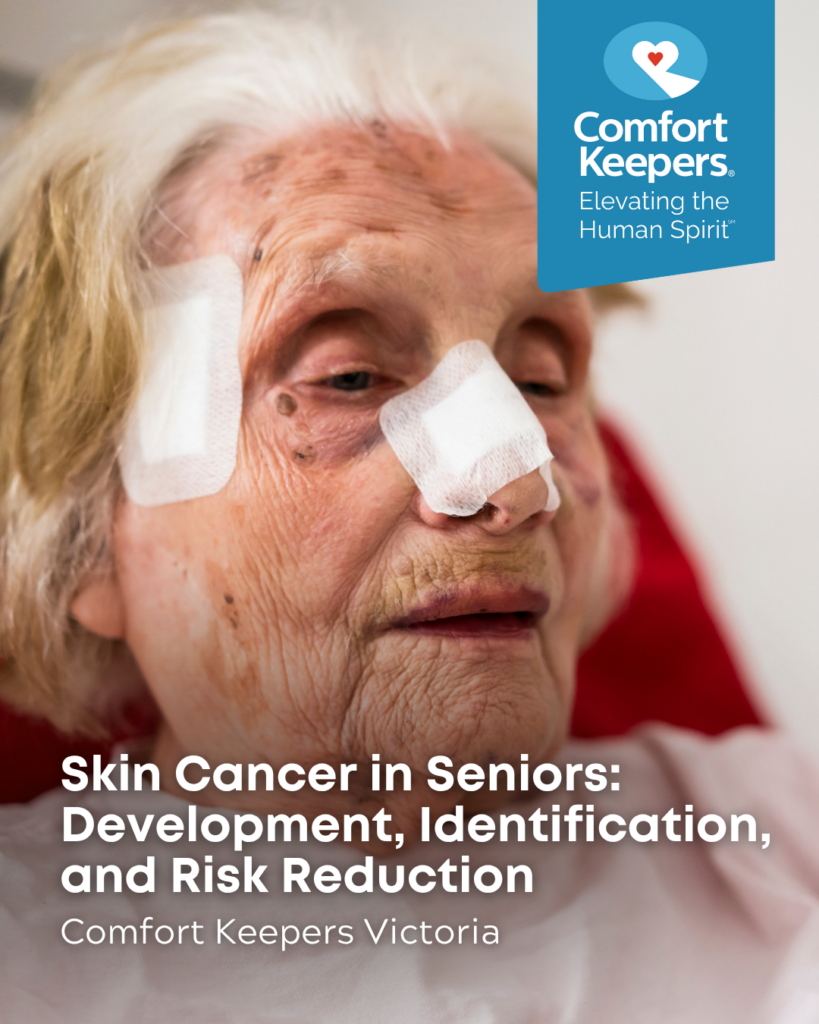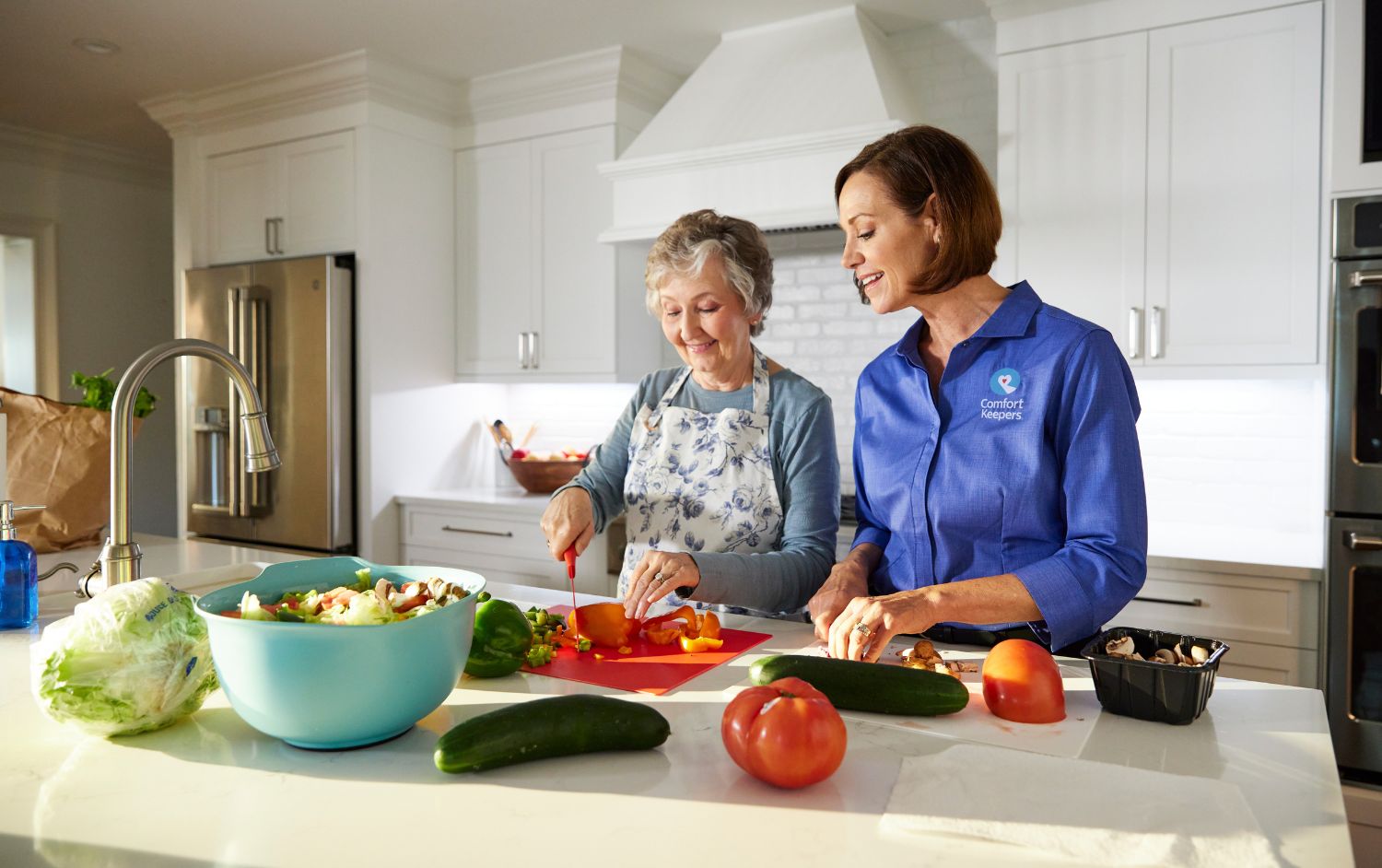Skin Cancer in Seniors: Development, Identification, and Risk Reduction
Victoria Senior Health | May 16, 2025

What Every Senior in Victoria, BC Needs to Know About Skin Cancer: On the Surface and On the Rise
Skin cancer is consistently reported to be the most common form of cancer in Canada. There are more new cases of skin cancer each year than the number of breast, prostate, lung and colon cancers combined. While many are aware of the three types of skin cancer – basal cell carcinoma, squamous cell carcinoma, and melanoma – the actual development of skin cancer may not be as well known. Below you will learn how skin cancer forms, the differences between the three types, and how your aging loved ones can identify and reduce the risk of skin cancer.
Fast Fact: According to the Canadian Skin Foundation, over 80,000 cases of skin cancer are diagnosed in Canada each year.
Development and Types of Skin Cancer in Seniors
The outer-most layer of our skin, known as the epidermis, is composed of three cells: squamous, basal, and melanocytes. Over time, as ultraviolet rays (from the sun or artificial sources like tanning beds) come into contact with the skin, DNA within the skin cells can become damaged, resulting in mutations. These mutations can then cause skin cells to multiply in quick succession, eventually invading the dermis layer of the skin. The classification of skin cancer depends solely on the epidermal skin cell from which it originated.
Basal cell and squamous cell carcinoma, two very common types of skin cancer, are considered highly curable and have been linked to those who spend a considerable amount of time outside and thus are frequently exposed to the sun. Melanoma, though less common, is recognized as more serious and potentially life-threatening. Resulting from the rapid growth of the aforementioned melanocyte cells, melanomas tend to manifest as red, brown, or pink mole-like formations or even form moles themselves.
For men, melanoma generally develops on the head or neck, and for women, it is often found on the legs, arms, or other extremities. That being said, melanoma can certainly develop in other areas of the body (wherever melanocytes are found), including the mouth, eyes, and even the gastrointestinal tract. Unlike squamous and basal carcinoma, melanoma is seen largely in those who have experienced sunburns from excessive exposure to the sun’s UV rays.
Identifying Melanoma in Seniors
Although the three types of skin cancer are generally considered curable if detected early enough, the possibility of early detection is largely contingent upon one’s own self-examination. To help with identification of melanoma-related areas, the American Academy of Dermatology has created an easy and helpful system. If your aging loved one is concerned about a particular mole or series of moles, help him or her follow the ABCDE’s of melanoma.
The A-B-C-D and Es of Skin Cancer:
Asymmetry:
If you were to draw a line right down the middle of the mole and both sides looked the same (or symmetrical), there’s a good chance it is benign. If, however, the two sides don’t match (or are asymmetrical), it could be a melanoma.
Border:
Pay close attention to the border of the mole. Benign moles generally have smooth borders, while melanomas have irregular or notched borders.
Color:
Another warning signal is if the mole has more than one color, including multiple shades of brown, black, or tan. Additionally, melanomas may become red or blue in appearance.
Diameter:
While benign moles are smaller in size, melanomas tend to be about ¼ inch or larger (or about the diameter of a pencil eraser).
Evolving:
Many of the characteristics listed above may change over time for a mole, in which case you will want to monitor closely. If other changes develop – such as itching, crusting, or bleeding – it could also indicate a melanoma.
Skin Cancer Risk Reduction for Seniors
As mentioned previously, older adults – those 65 years of age or older – are more likely to develop skin cancer than any other age group. The correlation behind this is not complex; seniors have lived longer than others and have had greater exposure to the sun’s UV rays. However, with some extra precaution, seniors can reduce their overall risk of skin cancer.
Here are Six Helpful Tips to Avoid Skin Cancer:
- Avoid tanning beds altogether.
- Use effective sun block (at least SPF 15).
- Avoid going outside between the hours of 10am and 4pm, if possible.
- Wear proper clothing (hat, sunglasses, light, loose-fitting shirts) to protect against UV rays.
- Find shade whenever possible.
- Examine your skin regularly (following the ABCDE’s), and follow up with a medical professional, if you suspect there may be a problem.
Comfort Keepers® Victoria Can Help
Our caregivers can establish a daily routine for your aging loved ones, to ensure that they are following the risk reduction tips above and keeping their skin protected from the sun’s UV rays. We can also help them get to any scheduled medical appointments, safely and on time. Call your local Comfort Keepers® office to learn more about our unique style of in-home care.
The Best Senior Home Care Provider in Victoria, BC, is Comfort Keepers®
Firstly, if you are concerned about the health and well-being of your aging loved ones, we can help with 24-hour care. We offer senior care, post-surgery care, palliative care, personal care, senior living transition services, and much more!
Comfort Keepers® Victoria Provides In-Home Elderly Care Services
Aging in place means keeping seniors happy and healthy at home. Comfort Keepers® trained caregivers provide seniors with the highest quality of life possible. In particular, our Interactive Caregiving™ system provides care that addresses safety, nutrition, mind, body, and activities of daily living.
Comfort Keepers® Victoria In-Home Caregivers Can Help with Interactive Caregiving™
Personal and empathetic care starts in the heart and allows us to meet our clients’ needs. Our philosophy is to elevate the human spirit. Our caregivers will be there every step of the way to ensure your loved one has a better quality of life.
Senior Homecare in Victoria, BC
Our unique services offer families respite care, overnight care, personal care, companionship care, palliative care, and end-of-life care. To learn more, contact the Comfort Keepers Victoria office.
Comfort Keepers® Victoria is Proud to Provide Senior Care and Home Care Services to Keep Seniors Safe in Their Homes
If you are searching for home care near you, we can help! Comfort Keepers® Victoria can provide home care for Victoria and surrounding areas. Service territory includes Colwood, Saanich, Sidney, James Bay, and Oak Bay. Please call (778) 265-5999 and learn how your loved ones can receive compassionate, professional in-home care.
Quality and Accredited Respite Care for British Columbia Families
Comfort Keepers® Victoria has achieved Exemplary Standing accreditation from Accreditation Canada. This accreditation, a rigorous evaluation of organizational processes, policies, and procedures against established quality standards by industry experts, signifies that Comfort Keepers’ offices have successfully met or surpassed the stringent benchmarks for Home Care companies as defined by Accreditation Canada.
References:
- Skin Cancer Foundation. “The Sun Keeps Rising: Why Seniors Can’t Skip UV Protection.” Web. 2016.
- NIH Senior Health. “Skin Cancer.” Web. 2017.
- Web MD. “Understanding Skin Cancer – The Basics” Web. 2017
- Canadian Skin Cancer Foundation. “About Skin Cancer.” Web. 2016.
Individualized Home Care Options
Long-Term Home Care, 24 Hour Home Care & Short Term Care Options Customized for You






